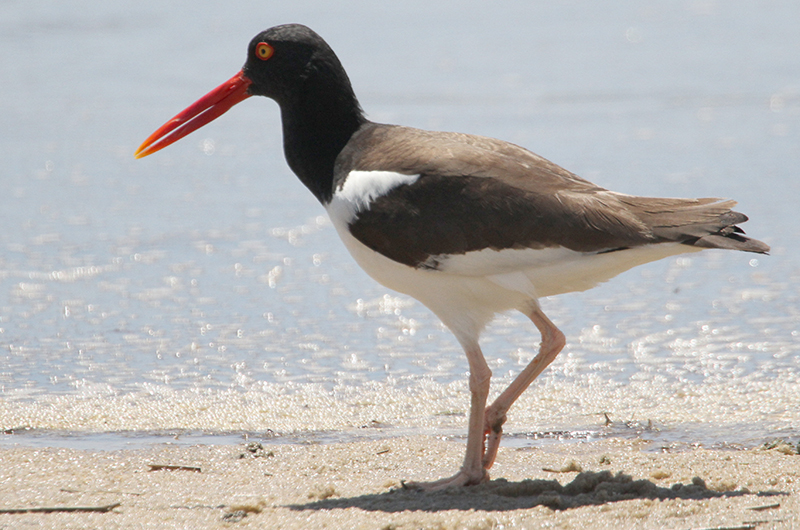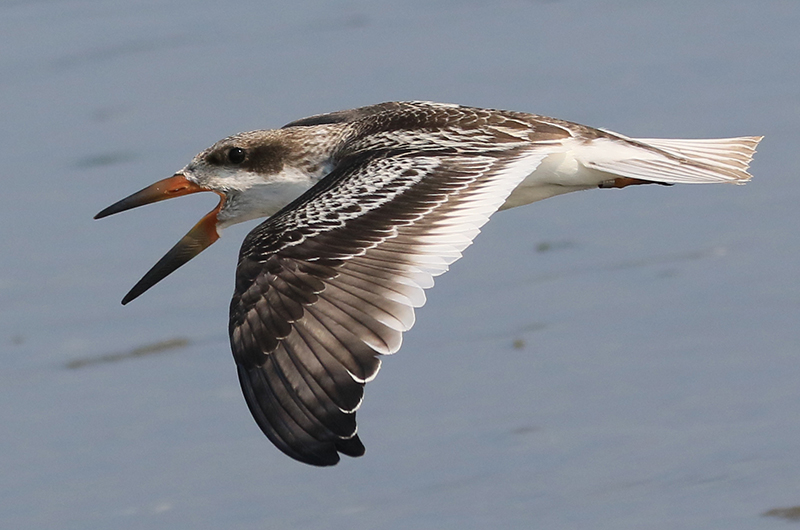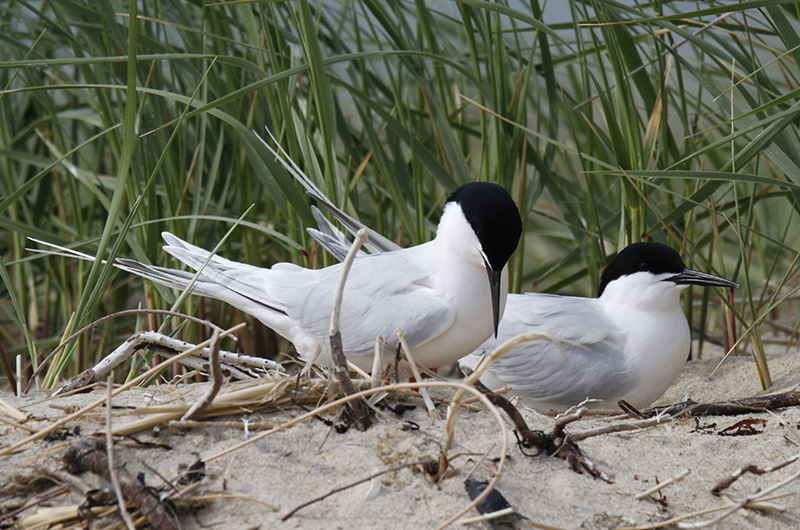The nesting season for our beach-nesting birds is now complete. Thanks to the tremendous efforts of BiodiversityWorks, The Trustees of Reservations, Martha’s Vineyard Land Bank and Felix Neck (Massachusetts Audubon Society), we know the breeding population of piping plovers, least terns, common terns, roseate terns and black skimmers that nested here this year.
There were 699 breeding pairs of piping plovers (federally threatened – in danger of becoming endangered) in Massachusetts this year; the Vineyard hosted 59 of them nesting on 21 different Island beaches this summer. About half of the plovers were on three beaches: 18 pairs were on Norton Point and Cape Poge, eight pairs were at Edgartown Great Pond and five pairs were at Dogfish Bar.

There were more American oystercatchers on the Island than in any other region of the state, as we hosted 52 of the 205 breeding pairs. This is slightly above the 13-year average of 191 pairs across the state.
There were 3,528 breeding pairs of least terns state-wide, which is close to the average number for the past 10 years. On the Vineyard, we hosted 721 pairs on 19 different beaches, with two large colonies of 297 nests on Norton Point Beach and 192 nests on Little Beach.
As their name suggests, common terns were the most abundant species in the state, with 19,800 breeding pairs. They were not the most common on the Island, however, as seven sites totaled only 55 breeding pairs. Sengekontacket Pond dominated these numbers with 32 pairs on Haystack Point and 10 pairs on Sarson’s Island.
Thirteen pairs of black skimmers nested here this year and this generally southern species did not nest anywhere else in the state. Eight pairs nested on Norton Point and five were on Little Beach. A late-June colony of seven pairs showed up on the Cape Poge elbow but they were likely second nest attempts of pairs that nested elsewhere in the early-June main census window.
Lastly, we had no roseate terns (federally endangered – in danger of going extinct) nesting on our beaches this year. This is the first year in a decade or so that they have not nested here but they were generally absent from our beaches prior to that. There were 2,249 pairs nesting in the state.
The productivity of piping plovers was also monitored. We fledged 0.88 chicks per pair this year, while every other region in the state fledged from 1.16 to 1.75 chicks per pair. Luanne Johnson of BiodoversityWorks – who compiles the Island-wide data for the state – is concerned about this low productivity; the Island has “the lowest or nearly the lowest productivity in the entire state over the last five years and in many years prior.” Studies have estimated that a stable population needs to recruit about 1.2 chicks per pair.
Potential reasons for this low productivity include human disturbance, predation and the weather.
The best survival of young chicks – which run around the beach within hours of hatching and feed themselves under their parent’s watchful eyes – occurs when the chicks can maximize the time they spend foraging.
It is fairly easy to determine when storm waves wipe out nests. But cool, wet weather also impacts chick survival, especially if the bad weather coincides with recently hatched chicks. The more the parents have to brood the chicks to maintain their body temperatures, the less time the chicks have to find and eat food, resulting in slower growth and higher mortality.
Adding human disturbance while the chicks are being brooded can also cause mortality. Such disturbance interrupts the brooding and leaves the chicks unprotected; they may die from prolonged exposure to cool, wet weather. Conversely, on hot sunny days the chicks spend more time being brooded/shaded from the sun. Human disturbance on these days – when everyone goes to the beach – can also increase mortality. We all know how hot the sand gets on these days, and unusually long exposure to this baking heat may kill the chicks. Putting up string fencing to keep us out of nesting areas reduces but cannot eliminate such mortality.
Predation is a natural component of the environment but, according to Luanne Johnson, “piping plovers are plagued by high rates of predation by crows, gulls and skunks and there is nothing natural about the level of predation they suffer.” While beach management can protect the plovers from some predation, it is also important to realize that populations of these native predators (yes, skunks have been here throughout our history – there was even a bounty on them in the late 1800s) are at unusually high levels due to our habits.
We can change that. We have all seen these predators patrolling parking lots and beaches because we feed them – either directly or by leaving litter and crumbs of food. This extra food aids their survival and trains them to go wherever we go, including to beaches. They do not stay out of posted areas and they will depredate any chicks they come across while on the beach.
Our actions away from the beach can also feed these predators. These predators frequent compost piles, trash barrels and Dumpsters because they find all sorts of tasty morsels there. Covering them or otherwise securing them so wild animals can not access the trash will help to reduce predator abundance. This is important for all trash cans, even those in public places like downtowns, parking lots, restaurants and beaches.
Our bird feeders are not put out to attract predators but they consume anything we put out for the songbirds. This extra food enhances the predator populations. We can adapt feeders to minimize the quantity of food these large predators get while maintaining their usefulness to the smaller songbirds that we want to attract.
Per Gus BenDavid: “Human activities support an unusually high population of predators. For predator populations to be reduced to natural levels, we need to stop providing them with extra food.”
The breeding season is winding down and southbound migrants are showing up. Please report all your sightings to birds@mvgazette.com.
Robert Culbert leads Saturday morning Guided Birding Tours and is an ecological consultant living in Vineyard Haven.










Comments
Comment policy »